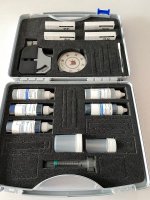How accurate do you need to be on the FC levels during SLAM?
Background: I’m in the UK and it’s impossible to find FAS-dpd based test kits. I’ve contacted all the companies listed on the forum topic for uk supplies but all have said they cannot supply in the UK now.
I have found this company
which does a HR Chlorine test 0-300ppm but it’s in 5ppm increments. Could I round up to nearest 5ppm and still have it work?
I’ve emailed them asking if they could do a variant that measures in lower increments but am waiting to hear back.
(they are geared towards industrial testing and would be great if you’ve got any power station cooling towers laying around in your back garden that you want to test)
The price they quoted on the HR test was reasonable too (£40 plus delivery).
Background: I’m in the UK and it’s impossible to find FAS-dpd based test kits. I’ve contacted all the companies listed on the forum topic for uk supplies but all have said they cannot supply in the UK now.
I have found this company
I’ve emailed them asking if they could do a variant that measures in lower increments but am waiting to hear back.
(they are geared towards industrial testing and would be great if you’ve got any power station cooling towers laying around in your back garden that you want to test)
The price they quoted on the HR test was reasonable too (£40 plus delivery).


